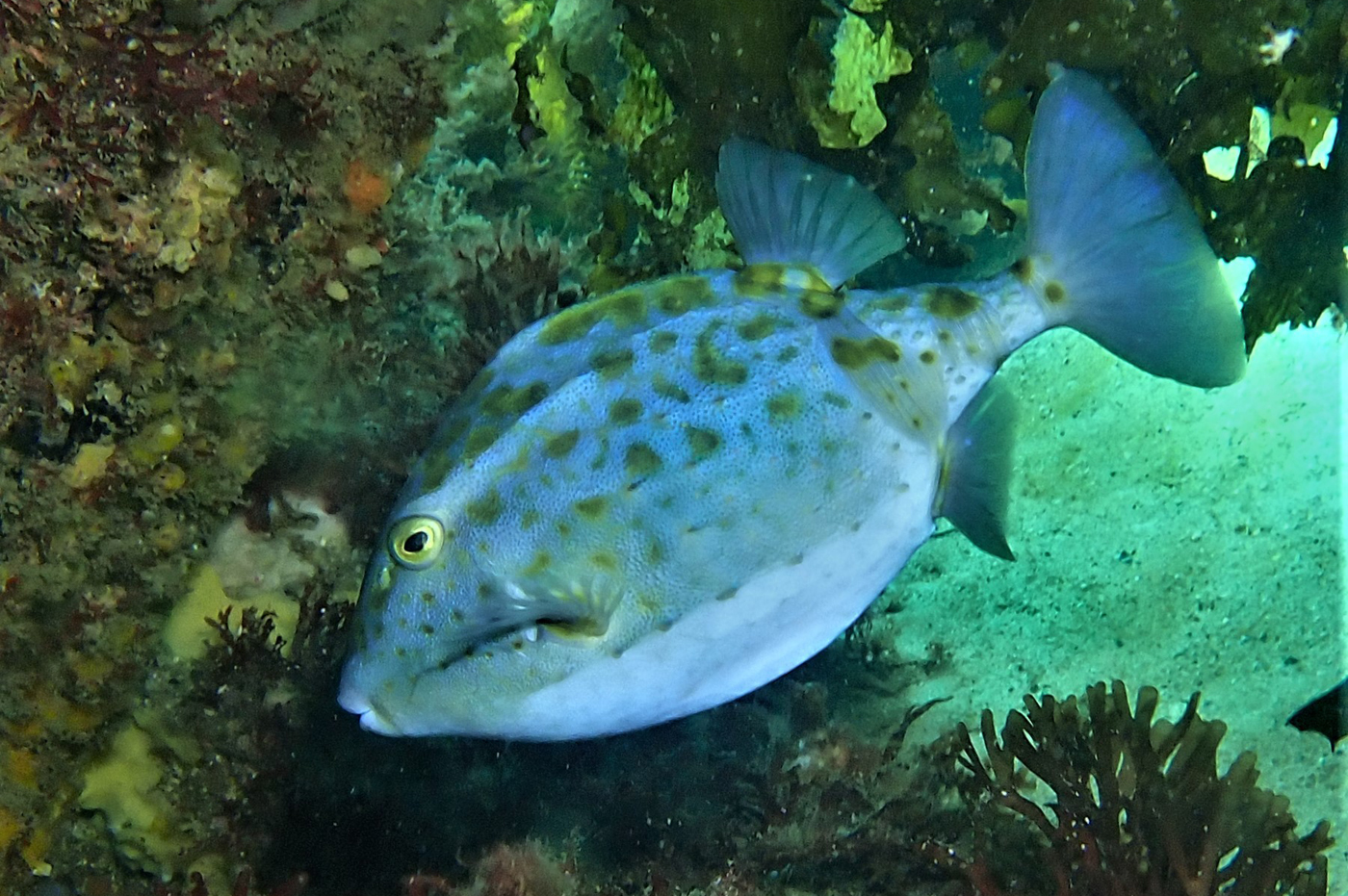- Classification
- ACTINOPTERYGII
- TETRAODONTIFORMES
- ARACANIDAE
- Anoplocapros
- amygdaloides
Western Smooth Boxfish, Anoplocapros amygdaloides Fraser-Brunner 1941

A male Western Smooth Boxfish, Anoplocapros amygdaloides, at Fremantle, Western Australia, February 2022. Source: jmartincrossley / iNaturalist.org. License: CC by Attribution-NonCommercial
Western Smooth Boxfish, Anoplocapros amygdaloides Fraser-Brunner 1941
More Info
|
Distribution |
Endemic to temperate waters of southern and southwestern Australia, from the eastern part of the Great Australian Bight, South Australia, to Shark Bay, Western Australia. Inhabits offshore reefs, seagrass beds and trawl grounds, at depths to 100 m. |
|
Features |
Dorsal fin 10; Anal fin 9-10; Pectoral fin 12; Caudal fin 11. Dorsal profile straight from snout to dorsal ridge; dorsal and lateral sides with nearly black spots. Two series of bony plates encircling caudal peduncle, anterior ring incomplete laterally, posterior ring continuous, plates covered with rough tubercles. |
|
Size |
To 30 cm TL |
|
Colour |
Body yellowish-white, paler below, with a brownish tinge above the ventrolateral ridge, dorsal and lateral sides of body with large dark spots mostly on the back and upper side; fins clear. Large males a pale bluish becoming paler below, with with brown blotches, lines and spots, and pale blue fins. |
|
Feeding |
Feeds on benthic invertebrates. |
|
Biology |
The sexes are separate and fertilization is external. The eggs and larvae are pelagic. |
|
Fisheries |
Of no interest to fisheries, although taken infrequently as incidental bycatch in commercial trawls. |
|
Conservation |
IUCN Red List Status: Least Concern |
|
Remarks |
Although the flesh is not poisonous, a mucous toxin, ostracitoxin, is present in boxfishes and some species can secrete the poison under stress. The toxin kills other fish, and eventually the boxfish themselves if exposed to it. As the precise location of this toxin in all species is not fully understood, boxfish should be considered potentially toxic to humans and their consumption as food should be avoided. |
|
Similar Species |
The Western Smooth Boxfish has long been confused with the Eastern Smooth Boxfish, Anoplocapros inermis. A. amygdaloides differs in having a straight the dorsal profile, the caudal peduncle completely encircled by bony plates just in front of caudal fin, and the dorsal and lateral sides with nearly black spots. A. inermis has a convex dorsal profile, the caudal peduncle partially encircled by bony plates just in front of caudal fin, and the dorsal and lateral sides plain, or with yellow to brown spots. |
|
Etymology |
The specific name amygdaloides is from the Greek amygdalus (= almond-like) in reference to the deep oval-shaped carapace with prominent elevated ridges that Fraser-Brunner considered were “suggestive of a large peach-stone”. |
|
Species Citation |
Anoplocapros amygdaloides Fraser‑Brunner, 1941, Ann. Mag. nat. Hist. (11)8: 308, fig. 1B. Type locality: Australia. |
|
Author |
Bray, D.J. 2022 |
|
Resources |
Western Smooth Boxfish, Anoplocapros amygdaloides Fraser-Brunner 1941
References
Edgar, G.J. 2008. Australian Marine Life: the plants and animals of temperate waters. Sydney : Reed New Holland 2nd edn, 624 pp.
Fraser-Brunner, A. 1941. Notes on the plectognath fishes. VII. The Aracanidae, a distinct family of ostraciontoid fishes, with descriptions of two new species. Annals and Magazine of Natural History 11 8(28): 306-313 figs 1-2, https://doi.org/10.1080/03745481.1943.9727991
Hoschke, A., Whisson, G. & Moore, G.I. 2019. Complete list of fishes from Rottnest Island. pp. 150-161 in Whisson, G. & Hoschke, A. (eds) The Rottnest Island fish book. 2nd ed. Perth : Aqua Research and Monitoring Services.
Hutchins, J.B. 1990. Fish survey of South Passage, Shark Bay, Western Australia. pp. 263-278 in Berry, P.F., Bradshaw, S.D. & Wilson, B.R. (eds). Research in Shark Bay: Report of the France-Australe Bicentenary Expedition Committee. Perth : Western Australian Museum. (as Anoplocaprus robustus)
Hutchins, J.B. 1994. A survey of the nearshore reef fish fauna of Western Australia's west and south coasts — The Leeuwin Province. Records of the Western Australian Museum, Supplement 46: 1-66 figs 1-6 (as Anoplocapros robustus)
Hutchins, J.B. 1997. Checklist of fishes of the Houtman Abrolhos Islands, Western Australia. pp. 239-253 in Wells, F. (ed.). The Marine Fauna and Flora of the Houtman Abrolhos Islands, Western Australia. Perth : Western Australian Museum. (as Anoplocapros robustus)
Hutchins, J.B. & Swainston, R. 1986. Sea Fishes of Southern Australia. Complete field guide for anglers and divers. Perth : Swainston Publishing 180 pp. (as Anoplocapros robustus)
Hutchins, J.B. & Thompson, M. 1983. The Marine and Estuarine Fishes of South-western Australia. Perth : Western Australian Museum 103 pp. 345 figs. (as Strophiurichthys robustus)
Kuiter, R.H. 1994. Family Aracanidae. pp. 892-902, figs 788-794 in Gomon, M.F., Glover, C.J.M. & Kuiter, R.H (eds). The Fishes of Australia's South Coast. Adelaide : State Printer 992 pp. 810 figs.
Kuiter, R.H. 1996. Guide to Sea Fishes of Australia. A comprehensive reference for divers and fishermen. Sydney, NSW, Australia : New Holland Publishers xvii, 434 pp.
Matsuura, K. 2008. Families Ostraciidae, Tetraodontidae. pp. 842-856 in Gomon, M.F., Bray, D.J. & Kuiter, R.H. (eds). Fishes of Australia's Southern Coast. Sydney : Reed New Holland 928 pp.
Matsuura, K., Amaoka, K. & Carpenter, K.E. 2020. Anoplocapros amygdaloides. The IUCN Red List of Threatened Species 2020: e.T162917863A162917900. https://dx.doi.org/10.2305/IUCN.UK.2020-1.RLTS.T162917863A162917900.en. Downloaded on 09 May 2021.May, J.L. & Maxwell, J.G.H. 1986. Field Guide to Trawl Fish from Temperate Waters of Australia. Hobart : CSIRO Division of Marine Research 492 pp.
Sampey, A., Fromont, J. & Johnston, D.J. 2011. Demersal and epibenthic fauna in a temperate marine embayment, Cockburn Sound, Western Australia: determination of key indicator species. Journal of the Royal Society of Western Australia 94(1): 9.










